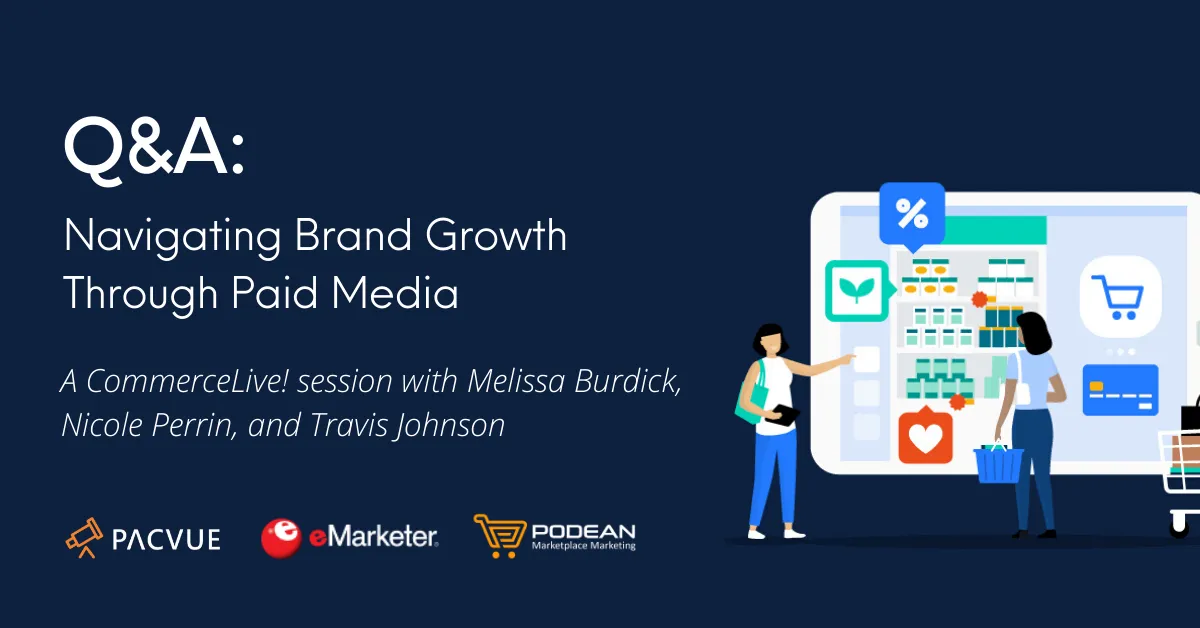On March 23, the ecommerce community came together for a virtual conference. A Slack channel enabled the community to interact, ask real time questions, get real time answers, and came as close as it could to replicating the ability to network with colleagues. Below are a few selected questions listeners posted in the Slack channel and the Pacvue team answered real time during Pacvue’s session on “Navigating Brand Growth through Paid Media”.
Q: Which strategy for Sponsored Products do you recommend in the current situation for non high-demand products?
A: It depends on your product, the product category, and especially whether or not your products fall within the six ‘household essential’ product categories that Amazon is prioritizing right now. If your items fall within these categories and you can sustain increased sales velocity and replenishment orders, we recommend testing out new campaigns with a relatively low daily investment and conservative CPC bid strategy at first. One good place to start might be Auto campaigns, given how easy they are to launch and how quickly you receive data back on which keywords customers are searching to be matched with your ads. Negative targeting can then be utilized in these Auto campaigns to refine your targeting set and reduce wasted spend. You could also test out targeting adjacent product categories, since many advertisers are currently going dark or running out of budget early in the day due to the spike in site traffic and searches.
Q: Do you have to rank organically before you can pay for a term on Walmart?
A: Yes, a product must rank within the top 128 items organically to be eligible for a sponsored product placement within search results on Walmart. If it doesn’t, your best option is Auto campaign placements, which appear on product pages and not within search results.
Q: Why are there still so few advertisers buying sponsored products on Walmart? One would expect grocery brands to be all over this? Is it because those budgets aren’t created yet?
A: In our experience, advertisers feel like they have a lack of experience with managing Walmart paid search ads and/or a lack of internal headcount or agency partners to manage. We have also seen some large brands that had not allocated budget for this when they originally set 2020 budgets, and are having to find these funds from current budgets. However, based on our data, competition is much lower on Walmart right now vs. Amazon, so we believe it’s a great time to start advertising, testing, and gaining data/results to inform future investments.
Q: Any perspective on what the new Walmart platform will look like from an advertising perspective when grocery and .com get combined?
A: I think the first step will be similar to how Amazon and Fresh operate, meaning you can’t separate Fresh as a platform and everything falls under one ad platform. I think how Walmart approaches this will come down to how they approach inventory, meaning more localized assortment on Grocery and national distribution on .com. For Grocery, advertisers will likely over-invest in the early stages to get on shoppers’ lists. We know that much of online grocery shopping happens from prior purchase lists.
Q: We are one of those companies with umbrella brands & sub-brands. Can you run ad campaigns only on the higher level registered brand, or can we do it at the sub-brand level with success even though it’s not the top-level brand on Amazon?
A: You can absolutely run campaigns with success for all sub-brands within your portfolio. We recommend establishing a ‘Right to Win’ strategy, meaning you would create a campaign structure that keeps sub brands separate, and then tier your campaign-level budgets and bidding strategies to give preference to your top brands or items. If all active advertising campaigns are managed from the same account, or if you ask Amazon to tie together separate advertising accounts on the back end, your campaigns will not compete with each other and you will not artificially raise your own CPCs.
Q: Have you seen an ad strategy work for driving impulse shopping? especially in categories like candy and snacks.
A: We have seen success here with Product Targeting on adjacent categories/ASINs with high affinity. Our thought is to surface our product as close to the conversion as possible on the adjacent product. We like Auto targeting to mine product adjacencies and then use manual targeting to further refine that list until you have a coherent Product Targeting strategy outside of the aisle. The ideal state would be to surface your products in the checkout landing screen, but that is wishful thinking for now.













